A | Introduction by the Registrar
The Registrar of the Court of Justice, the Secretary- General of the Institution, oversees the administrative departments under the authority of the President. He attests to the departments’ commitment to supporting the Institution’s judicial activities in a year in which those departments faced unprecedented challenges.

Alfredo Calot Escobar
Registrar of the Court of Justice
In individual terms, 2020 was a trying year for everyone owing to restrictions, illness and uncertainty, which were the hallmarks of that period.
In terms of managing the Institution’s various departments, 2020 was a significant challenge, taken up methodically with determination and resilience. This required a complete transformation of the Institution’s operating methods in very short order. No department was spared by that necessity to adapt, to innovate, to reinvent itself.
Fortunately, the Institution was able to rely on a structure and procedures which had already been established to deal with crisis situations. That structure is based on a crisis unit, which has competence to adopt, in respect of the Institution as a whole, major decisions linked to the crisis situation and developments therein. It then takes the necessary general measures (remote working scheme, cross-cutting measures relating to staff management, and so forth). Those general decisions are then implemented by the Crisis Management Centre (CMC), which is composed of representatives of all operational units ensuring the continuity of activity within each department. During its regular meetings, the CMC also ensured that relevant information was passed up to the crisis unit, allowing the situation to be managed.

That crisis management, which brought closely together the various departments and the two courts within the Institution, allowed consistent action to be taken with three concomitant and interdependent objectives at its core: guaranteeing the health and safety of staff members and any persons needing to be on the Institution’s premises; ensuring the continuity of judicial activity; and supporting staff members.
With a view to guaranteeing health and safety within the Institution’s buildings and protecting staff from the risk of infection, it was decided, on 10 March, that all suitable tasks were to be performed from home by those persons responsible for carrying them out. This system of working from home was subsequently generalised and made mandatory from Monday 16 March, even before the national authorities decided on lockdown measures. Court premises could thus no longer be accessed, except by those persons required to perform essential tasks that could not be carried out remotely. Thanks to constant monitoring of health and regulatory developments in Luxembourg and neighbouring countries by the Court’s security department and medical service, working in regular concertation with the Luxembourg authorities, the scheme was adapted to various phases, striving to strike a balance between health conditions, attendance on Court premises, maintaining judicial activity and the needs of staff members.
In parallel with the remote working scheme, one of the key tools in protecting human health was the definition and implementation of strict and specific health protocols. To allow EU justice to continue to be dispensed, the Court of Justice re- opened its courtrooms on 25 May. Consequently, the daily presence on the premises not only of those staff members necessary to the organisation of hearings, but also of lawyers and agents from all over the European Union, had to be managed in terms of logistics and of health and safety. The particularly exacting measures put in place (temperature check on entry to the buildings, compulsory wearing of masks in communal areas, physical distancing measures by establishing separate lanes for human traffic, disinfection of those areas where people had been present, installation of alcohol gel dispensers, protective screens, signposting, raising awareness through a variety of communications) all served to guarantee the highest level of protection for all persons involved while offering them satisfactory reception conditions.
This resumption of public hearings was necessary in order to ensure that European justice continued to be served in the public interest. Prior to the resumption of hearings, judicial activity was maintained by dealing with cases remotely, in particular by means of adapted procedural arrangements. Representatives of parties were duly informed of the procedural consequences of the crisis and of the measures adopted by the Registries of the Court of Justice and the General Court, through a dedicated page on the Institution’s website.
From a technical perspective, the Institution’s IT department accelerated the remote working equipment programme in February. Bandwidth was increased tenfold in the first few weeks of the first lockdown and a secure audio then videoconference system was very quickly made available to all departments.
As the following pages describe in detail, the Institution had to innovate in order to address the travel difficulties faced by a number of legal representatives of parties to proceedings. The fruit of a remarkable cooperation between the various departments, the two courts and their registries, a single system for remote participation in hearings via videoconference was designed, offering simultaneous interpreting potentially to and from the EU's 24 official languages.

Lastly, as part of the efficient management of resources, certain members of staff, who had experienced a drop in their professional activity on account of their respective roles, were temporarily reassigned on a regular basis to those departments dealing, conversely, with additional work. This solidarity and mutual enhancement of skills and experience were assets in dealing with difficulties and will be equally valuable to the successful return of staff members to the Institution’s premises.
The last of the objectives pursued in this context of crisis management was that of supporting staff through an unprecedented period characterised by difficult personal circumstances.
Particular attention was paid to them, whether they were persons suffering from the virus or those at risk of infection, isolated individuals or those having to care for children at home. They received assistance from the Human Resources Department, the doctors and nurses from the medical service, and from a consulting psychologist. In the context of an approach putting the care of our staff first and foremost, heads of department also took into account such specific situations in order to adapt the working arrangement of the persons concerned.
Furthermore, from the very beginning of the crisis, the Institution was particularly aware of the need to ensure clear, accessible, consistent and relevant communication with its staff. Additional structured channels of communication were put in place, each with its own purpose: an intranet page containing all relevant information, important messages sent to work and personal email address from a dedicated email account and also via text message, communications to staff of an operational nature sent by email and intended to provide information on a regular basis concerning developments in the health situation and support measures put in place.
The range of e-learning courses was enhanced so as to allow members of staff to continue to develop their skills. Senior and middle management were also given specific training on managing remote teams.
Two surveys were conducted of all staff and of management, respectively, to gauge their views on the work arrangements put in place, so as to make adjustments thereto and look ahead, in the longer term, to innovations in a crisis management context.
Lastly, in the inter-institutional sphere that is the Board of Heads of Administration of the institutions and bodies located in Luxembourg, the foundations for cooperation with the competent Luxembourg authorities were laid in December 2020 so that the institutions might contribute, to the best of their abilities, to the success of the vaccination campaign, for staff of the EU institutions.

The pandemic and the need to find solutions to deal with its consequences for the organisation of the Institution led to an impressive acceleration in the developments that were either already under way or simply in their early stages.
Beyond the pride to be drawn from working together to maintain a level of activity almost equivalent to that seen previously and continue with ongoing projects while ensuring the highest possible levels of health and safety, the management of such an unprecedented period for the Institution opens the way for positive, sustainable changes in working methods, or even working relationships, together with all of the possibilities offered by virtual work attendance.
Working from home (full- or part-time) has been a reality for all members of staff since 16 March 2020. At each stage of the introduction of the scheme, dictated by the prevailing circumstances, the consequences of these new ways of working came to light quite naturally: digitising and simplifying decision-making processes; fostering greater independence for staff and maintaining the quality of their performance; adjusting work-life balance; demonstrating a strong esprit de corps with and within the Institution; and getting closer to external counterparts – be they institutions or citizens – thanks to the opportunities presented by new technologies.
When the restrictions associated with the pandemic are behind us, it will fall to the Institution to sustain the benefits of these developments, as part of a return to working life the conditions of which will be entirely new and all the richer. The obstacles overcome are experiences which have made us individually and collectively stronger, more responsible and united. And if the Institution has been able to face up to such an unfavourable situation successfully, this is thanks to the commitment and cohesion of its staff, together with the dedication and concern of its management. The Institution will in future be able to rely on those qualities in preparing for the return of its staff and fostering a strong esprit de corps in an environment where mobility and responsibility will feature amongst the new parameters of its organisation.
Alfredo Calot Escobar
Registrar of the Court of Justice


ALT TEST TIMELINE COVID EN
On the 10th of March 2020, the Court of Justice took a Decision adopting a policy of generalised remote working.
On the 13th of March 2020, the Court of Justice took a Decision ordering all staff to work from home.
On the 16th of March 2020, the generalised remote working scheme was implemented.
In March 2020, the Court of Justice completed 27 cases, in comparison to 73 in 2019, and the General Court completed 26 cases, in comparison to 52 in 2019.
In April 2020, the Court of Justice completed 75 Cases, in comparison to 47 in 2019, and the General Court completed 36 cases, in comparison to 67 in 2019.
On the 25th of May 2020, the Court of Justice held its first hearing via videoconference.
In May 2020, the Court of Justice completed 49 cases, in comparison to 81 in 2019, and held 3 hearings, 2 of which were via videoconference. The General Court completed 76 cases, in comparison to 86 in 2019.
On the 30th of June 2020, the General Court held its first hearing via videoconference.
In June 2020, the Court of justice completed 74 cases, in comparison to 64 in 2019, and held 19 hearings, 3 of which were via videoconference, in comparison to 23 hearings in 2019. The General Court completed 57 Cases in comparison to 109 in 2019, and held 23 hearings, 1 of which was via videoconference, in comparison to 22 hearings in 2019.
In July 2020, the Court of Justice completed 78 cases, in comparison to 76 in 2019, and held 13 hearings, 7 of which were via videoconference, in comparison to 12 hearings in 2019. The General Court completed 87 cases, in comparison to 72 in 2019, and held 22 hearings, 2 of which were via videoconference, in comparison to 21 hearings in 2019.
In August 2020, the Court of Justice completed 7 cases, in comparison to 4 in 2019. The General Court completed 14 cases, in comparison to 1 in 2019.
In September 2020, the Court of Justice completed 91 cases, in comparison to 99 in 2019, and held 26 hearings, 7 of which were via videoconference, in comparison to 34 hearings in 2019. The General Court completed 95 cases, in comparison to 156 in 2019, and held 39 hearings, 5 of which were via videoconference, in comparison to 24 hearings in 2019.
In October 2020 the Court of Justice completed 110 cases, in comparison to 99 in 2019, and held 14 hearings, 9 of which were via videoconference, in comparison to 20 hearings in 2019. The General Court completed 109 cases, in comparison to 51 in 2019, and held 52 hearings, 8 of which were via videoconference, in comparison to 20 hearings in 2019.
In November 2020, the Court of Justice completed 58 cases, in comparison to 97 in 2019, and held 12 hearings, 8 of which were via videoconference, in comparison to 21 hearings in 2019. The General Court completed 42 cases, in comparison to 54 in 2019, and held 25 hearings, 14 of which were via videoconference, in comparison to 14 hearings in 2019.
In December 2020, the Court of Justice completed 69 cases, in comparison to 107 in 2019, and held 5 hearings, 4 of which were via videoconference, in comparison to 20 hearings in 2019. The General Court completed 88 cases, in comparison to 71 in 2019, and held 12 hearings, 8 of which were via videoconference, in comparison to 23 hearings in 2019.
C | Overview of the Court’s activity during the pandemic
The Court’s continued judicial activity during the pandemic has consisted in measures implemented to ensure the proper functioning of European justice, but also to continue to inform European citizens of their rights and of the activities of the EU Courts. Whether it be developing a system allowing the remote submission of oral arguments with simultaneous interpretation or internal and external communication campaigns, the Court has shown initiative and adaptability. With the Institution’s buildings initially closed and subsequently subject to strict health rules, there were necessarily fewer visits from the general public and legal professionals or for on-site consultation of library publications, but alternatives were immediately proposed by the Court.

252 oral hearings
Hearings via videoconference(between 25 May and 22 December)
40 before the Court of Justice
38 before the General Court
A total of 252 oral hearings (which could, in some instances, concern several cases argued before the same composition of the court) were held between 25 May and 22 December 2020. That figure includes 40 hearings before the Court of Justice which involved parties (between one and four) appearing remotely via videoconference, and 38 hearings before the General Court involving parties (between one and three) appearing remotely.
The life of the Institution and administrative activities also went on, with the arrival, between March 2020 and December 2020, of a number of new Members. The entry into office of the new French Advocate General, Jean Richard de la Tour, gave rise to a fresh innovation: he took the oath remotely, via interposed screens, in the presence of President Lenaerts, First Advocate General Szpunar and Registrar Calot Escobar. Subsequently, on 10 September, Athanasios Rantos, the Greek Advocate General and, on 6 October, Jan Passer, the Czech Judge of the Court of Justice, and Ineta Ziemele, the Latvian Judge of the Court of Justice, all took the oath in situ before the Court, with the necessary health measures still in place.
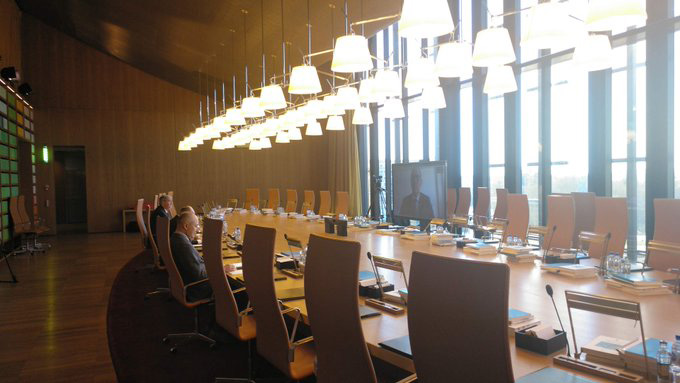
All of the Institution’s departments and services have had to adapt their internal communication methods since March. By making use of videoconferencing technology, teams have been able to meet and continue to work remotely. Accordingly, on average, more than 150 videoconferences or audioconferences were held per week, for internal or inter-institutional meetings.
As regards external communications, the Court implemented a range of remote campaigns using social media and other technological means to reach specialist or professional audiences and the general public, and to ensure the appropriate dissemination of its decisions.
Throughout the year, the Court also held 29 formal face-to-face events, in line with particularly exacting requirements, as well as 5 official visits and 5 formal sittings. In that context, 171 national judges were received by the Court. While those visits took place, for the most part, before the restrictions on access required by the fight against the spread of Covid-19, the Court of Justice was, occasionally, able to host a number of key events (the swearing in of members of the European Public Prosecutor’s Office on 28 September, and the formal sitting marking the entry into office of judges Ineta Ziemele and Jan Passer on 6 October), the conduct of which had to be adapted in the light of health constraints.
Lastly, the Institution’s Members and staff can rely on the Library’s collections, which contain some 285 000 publications (including 155 000 works relating primarily to European Union law), over 6 300 e-books, 490 subscriptions to periodicals in hard copy as well as several hundred in digital format which can be accessed through over a hundred databases. In the context of the publication of the Institution’s case-law, 35 019 documents were published in the Reports in 2020. Since 13 March 2020, the Information Desk has introduced various means for using documentary resources remotely so as to compensate for the closure of the reading room (159 digitisations on request and 724 publications loaned through the Biblio-drive, a stand- alone system for borrowing and returning publications).

page-s3.sub-3.region-2.graph-1.paragraph-1
page-s3.sub-3.region-2.graph-1.paragraph-2
page-s3.sub-3.region-2.graph-1.paragraph-3
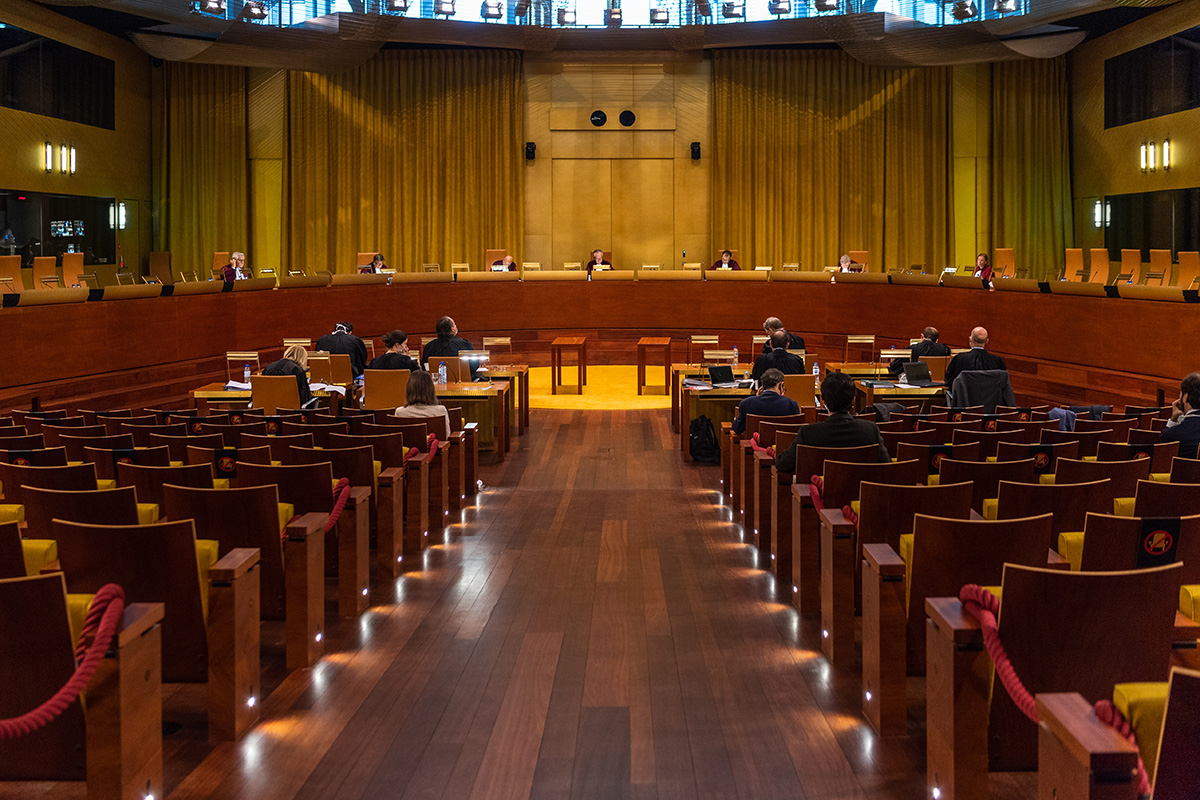

Hearings conducted remotely
In response to travel restrictions imposed by the Member States, the Institution designed a videoconference system which allows, by way of exception, representatives of the parties not able to travel in person to Luxembourg to take part, remotely, in the hearing, in compliance with the principle of multilingualism. Two of the system’s users share their experiences.
Submitting oral arguments remotely

by Viktorija Soņeca, Director of the Ministry of Justice of the Republic of Latvia, Agent representing the Republic of Latvia in proceedings before the Court of Justice
‘I am honoured to be invited by the Court of Justice of the European Union (CJEU) to share my experience of using videoconferencing in hearings at the Court and to express my views on the system.
It should be pointed out, first of all, that the process of digital transformation began in the European Union well before 2020. However, this year will go down in history not only on account of COVID-19 and its consequences, but also for the turning point that it represents in terms of digitisation and the use of videoconference technology in the context of hearings at the CJEU.
This is because, whilst the list of negative consequences of COVID-19 is long, the pandemic has facilitated the acquisition of digital skills and accelerated the implementation of digital solutions in everyday life. In this regard, undertakings, institutions and individuals have started to use digital solutions to improve their everyday lives, to work better and more efficiently, and to improve communication with national courts and the CJEU.

In 2020, Member States and parties to proceedings pending before the CJEU were given the opportunity to participate in hearings before the Court via videoconference. Thanks to this technology, Member States and parties were able to state their views during the hearings and to respond not only to questions posed by the CJEU, but also to questions and remarks from other parties and Member States. As it is with face-to-face hearings, an interpretation service is available during the videoconference, made possible by the enormous amount of work carried out by interpreters to translate simultaneously the words spoken during hearings so that all participants can understand what is being said.
The conduct of oral hearings has not changed, except that Member State officials and representatives of the parties can remain in their country and participate remotely. Such a possibility brings with it, of course, its share of advantages – convenience, safety, and the time gained in journey time – and disadvantages, such as the fact that it is not possible to soak up the spirit of the CJEU, a wonderful experience that is renewed each time one enters a courtroom of the CJEU to argue the case, in person, before the Court.
It should also be pointed out that the CJEU, by making it possible to use videoconferencing for hearings, has demonstrated that it can adapt to the circumstances and that proceedings must follow their proper course despite the health crisis’.
The unprecedented challenges of remote interpretation
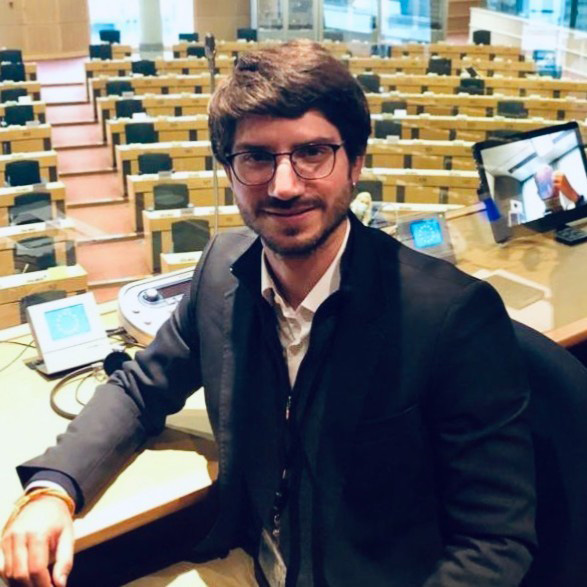
by Ignasi Vancells Mora, freelance conference interpreter
The conduct of hearings in which some of the parties participate remotely has had significant repercussions on the work of interpreters.
A freelance interpreter from the Spanish interpretation booth who works regularly for the Court explains what working as an interpreter for the EU institutions – and more particularly the Court of Justice – has meant in 2020.
‘2020 has been unusual for everyone. For all interpreters, the pandemic first of all brought activities to a complete halt, in part due to the cancellation of international meetings. When they resumed, working conditions were quite different. For freelance interpreters, this new way of working raised many questions: how to get around given the travel restrictions in place and how to work under good health and technical conditions? Videoconferencing, which has made it possible to hold online meetings, has raised a number of concerns relating to the reliability of remote access connections and sound quality which is rarely the same as being in the same room. You have to work harder to understand speakers and you tire more quickly.
That said, I find the Court’s remote access connections during hearings to be generally of good quality. Of course it is impossible to guarantee optimum quality at all times, but I believe that everything is being done to try to do so, in particular thanks to a series of tests carried out beforehand with interpreters. Furthermore, the standard of communication in informing parties and interpreters in advance of any changes in the new working arrangements or relating to preparatory work is excellent. Freelance interpreters are clearly informed of these upon the conclusion of the contract.
Remarkable efforts have been made by the Institution to ensure that the best possible working conditions are maintained. I have been impressed by the thoroughness and rigour of health measures: in addition to what is normally done, interpreters don’t share anything (laptops, headsets or desks).
We don’t even share the same booths anymore, so it is more difficult to communicate with or even to hear the interpretation of our colleagues. This can interfere with the consistency of the terminology that we employ; we have to coordinate in advance. When faced with one difficulty or another (a terminological question, a technical problem, and so forth), it is more complicated to help each other whilst interpreting. For some questions, we communicate by gesturing and, for others, via mobile phone or instant messaging.
In this context, preparation for the hearing is essential and the Court is, moreover, the only institution where ACI interpreters devote a full day’s work to preparation, just like staff interpreters. In this regard, I’ve barely noticed any difference since the start of the pandemic. Our colleagues are just as available, albeit more so via e-mail and SMS, and there are no more casual conversations in corridors.
I believe that, at the beginning, many were frightened by the prospect of what the pandemic could mean for our profession. But, after the initial shock, solutions were found and we have adapted and found a way forward’.
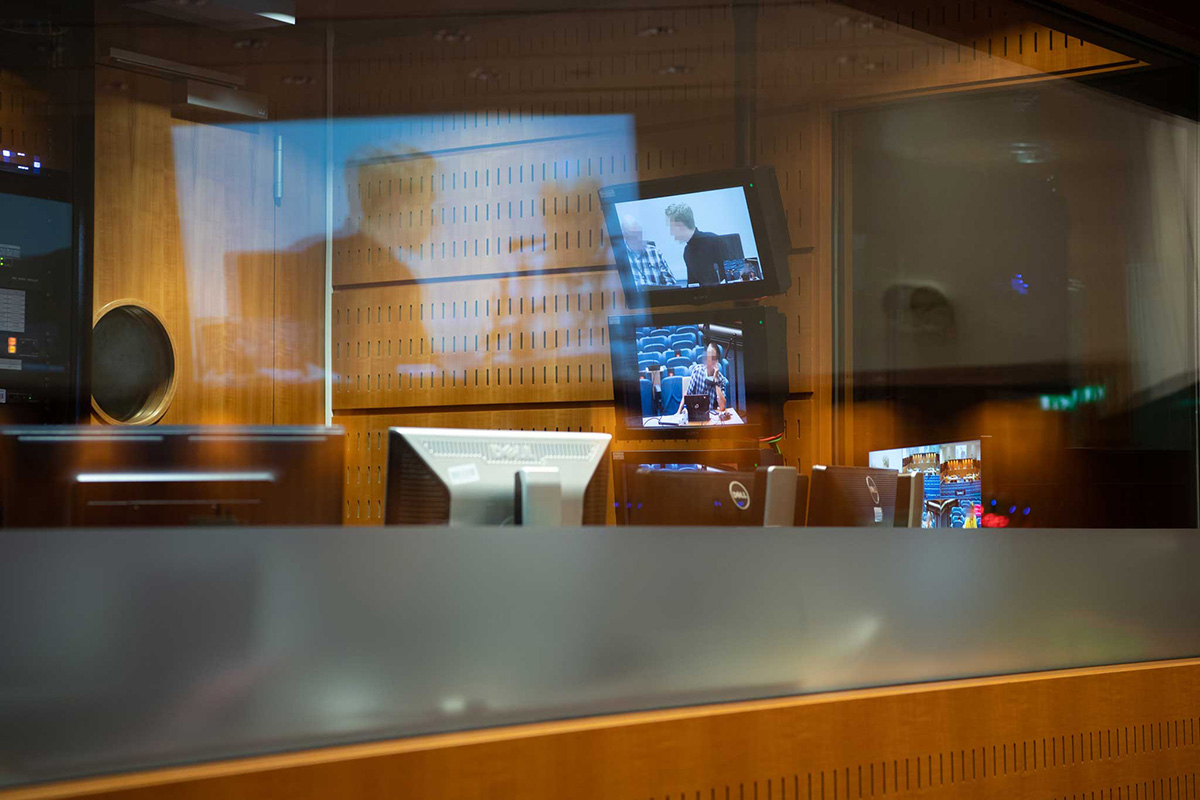

Public relations
Dialogue with legal professionals and the general public continued throughout 2020. Whilst traditional channels were maintained, virtual dialogue was enhanced through videoconference services and social media platforms.

127 groups
A total of 3 729 visitors
21 virtual tours for 798 visitors
The use of traditional communication channels by the Communications Directorate continued but emphasis was placed on an increased use of social media. 142 press releases were published between 16 March and 22 December 2020. The Court’s Twitter and LinkedIn accounts (in French and English) were used to share Court news: 668 messages, or ‘tweets’, were sent via Twitter to keep followers informed. These tweets were intended, on the one hand, to draw attention to the main cases to be dealt with the following week and, on the other, to relay the publication of press releases.
Organising visits is an important activity for the Court as part of its policy of openness and knowledge-sharing not only with regard to legal professionals and law students but also European citizens. The health measures adopted from March 2020 precluded the organisation of such visits and the ability to receive visitors. Whilst the overall figures – 127 groups with a total of 3 729 visitors – are inevitably lower than in previous years (18 099 people in 2019), the Court has nevertheless found new ways to make its buildings and activities accessible to the public. It thus organised meetings across digital platforms with Court officials conducting a virtual tour of the Palais building complex, along with ‘tailor-made’ webinars held over two days with the participation of Members, référendaires (law clerks) and administrators at the Court. The webinars gave 798 people across 21 virtual visits the opportunity to attend the presentations given.
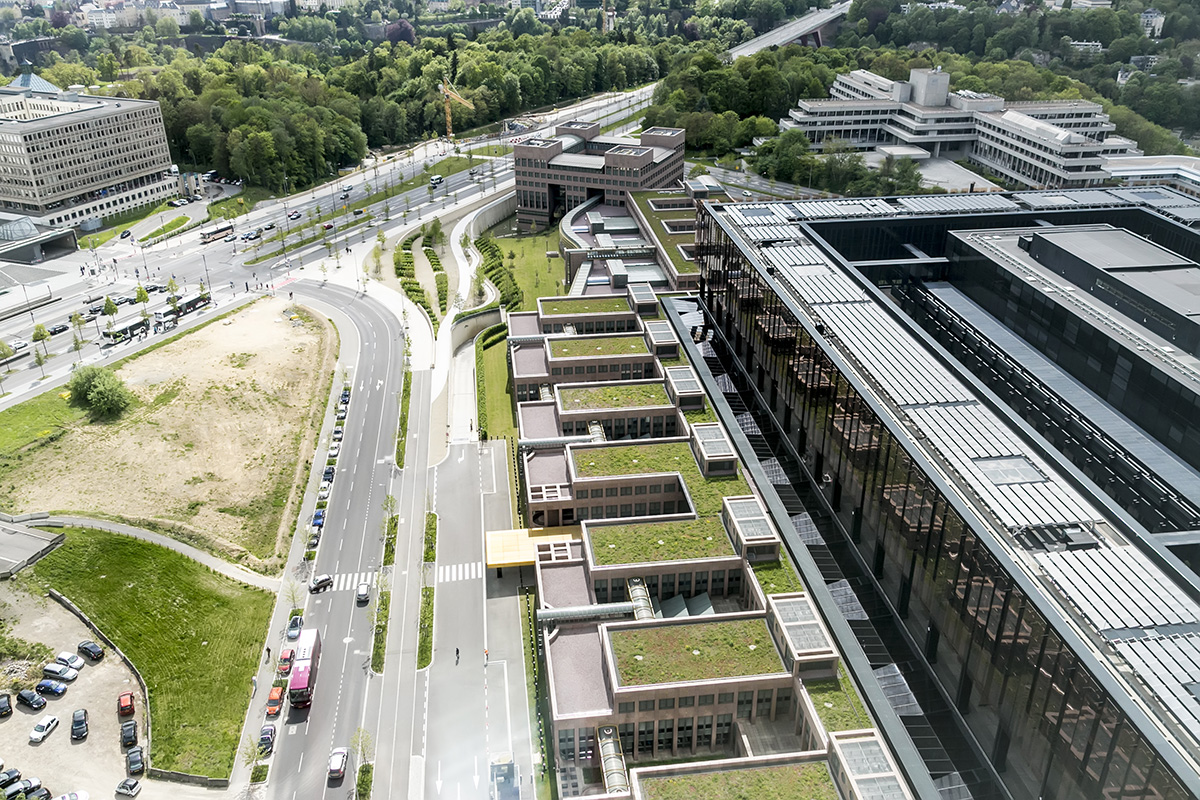

Jan 1 - Dec 31
173 press releases
2 292 language versions
702 tweets
273 posts on LinkedIn
17 174 requests for information received from citizens
The Court, through the Communications Directorate, issued 173 press releases (a total of 2 292 language versions) to inform professionals and the general public (3 366 recipients included on the mailing list) about its decisions, as well as events organised within the Institution. The curia.europa.eu website received more than 6.6 million visits and more than 27 million pages were viewed.
The Institution maintained its presence on social media, posting 702 tweets on Twitter via the Court’s two accounts – one in French, the other in English. 273 messages were also posted on LinkedIn.
Given that it was not possible to hold events such as the annual Open Day, it was decided that social media would be used to introduce the public around the world to the functioning of the Court. Three virtual events were therefore held exclusively on social media on the occasion of Europe Day (9 May), the European Day of Justice (24 October) and the anniversary of the creation of the Court of Justice (4 December): presentations on Court rulings, activities focused on certain themes arising from the case-law, question-and-answer sessions. These three events were a big hit with the Court’s following, which has grown steadily throughout the year to exceed 90 000 followers on LinkedIn and 100 000 followers on Twitter. These three events generated a total of 1 713 000 impressions on Twitter (the number of times the tweet is seen) and 258 000 views on LinkedIn.
In parallel with this, online press briefings dedicated to procedural news were organised for journalists. The 11 press briefings brought together a total of 94 journalists.
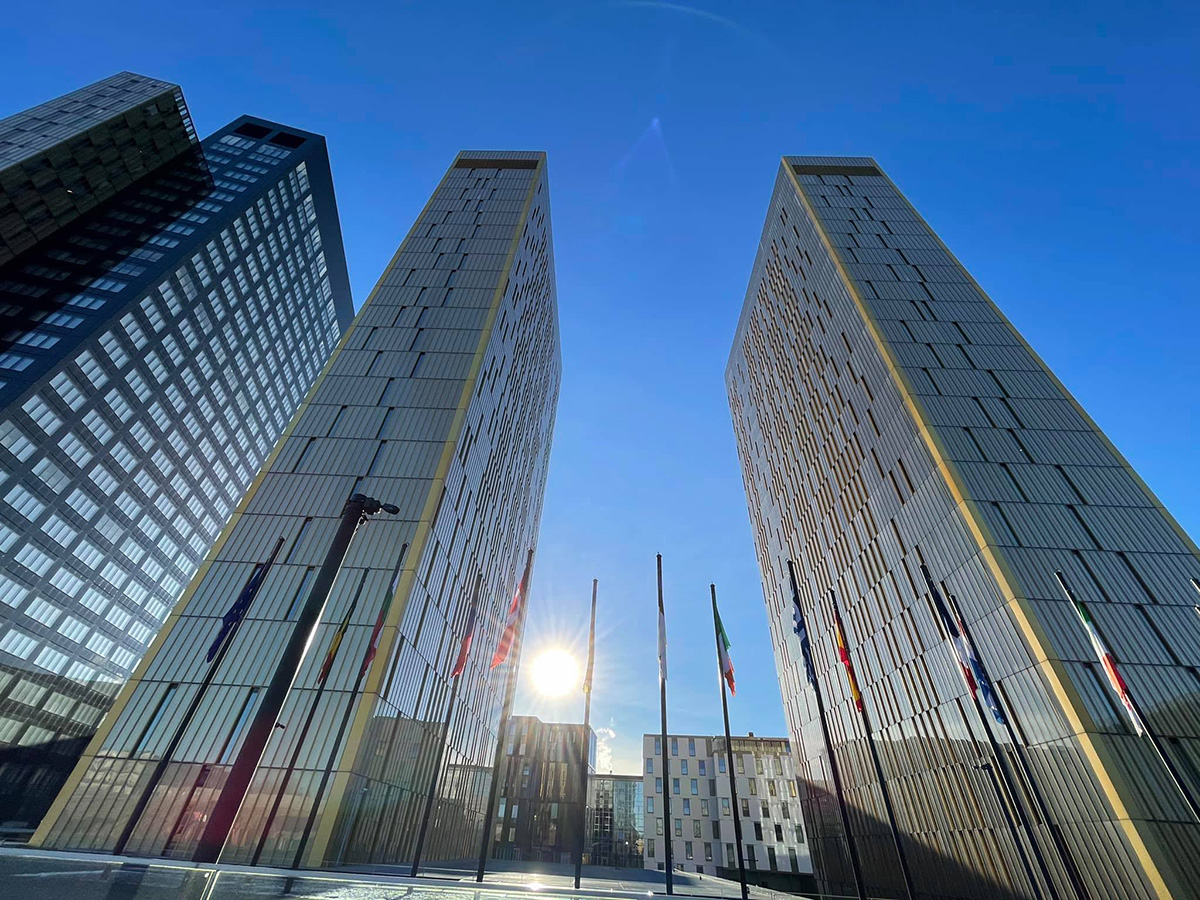
In accordance with the applicable regulation, the Court granted access to its administrative documents and historical archives in response to 103 requests. The Court also responded to 17 174 requests for information from citizens concerning cases pending before it or its case-law, the functioning of the Court and its jurisdiction.
Lastly, the Judicial Network of the European Union, founded in March 2017 on the 60th anniversary of the Treaties of Rome, which brings together the Constitutional and Supreme Courts of the Member States, met several times via videoconference in two thematic groups: ‘Innovation’ and ‘Legal Terminology’. These meetings were an opportunity to exchange information on the use of new technology in support of court activity and to share translation resources which may be used by national courts and tribunals.



The contribution of the Directorate-General for Multilingualism to ensuring continuity of the functioning of the Institution

By Thierry Lefèvre, Director-General for Multilingualism
Multilingualism lies at the heart of judicial proceedings at the Court of Justice. If that were not the case, citizens would not have access to European justice or its case-law, yet this activity creates rights and obligations. Faced with the sudden emergence of the health crisis, the Directorate- General for Multilingualism (DGM) has thus had to fulfil the mandate entrusted to it, whilst ensuring the safety of staff.
Specifically, at the outbreak of the pandemic, the first months of the year ran smoothly. From the end of February, the DGM activated its crisis management unit and considered implementing plans to ensure continuity, in close collaboration with the other departments of the Court of Justice and the Chambers of the Judges and Advocates General.
On 13 March, three days before the national lockdown, all staff were informed that they would not be working on Court premises. Absolute priority was given to protecting the health of colleagues and preventing the spread of the virus. Once this two-fold objective had been met, the DGM turned its attention to the continuity of the service. It was first of all necessary to show flexibility and creativity in managing specific aspects of the crisis, with staff facing unforeseen and often uncomfortable working conditions. It was then necessary to demonstrate endurance in view of the unforeseen – and as yet uncertain – duration of the crisis.
As regards legal translation specifically, both collective and individual objectives took into account, in the early stages of lockdown and where the situation justified the same, the personal situation of staff members of the Directorate-General (isolation, children at home, and so forth). As the crisis was widespread, the temporary drop in capacity was offset by a fall in demand for translations. Subsequently, the organisational measures and the commitment shown by everyone, combined with the benefits of continuous investment in new technologies and optimised outsourcing, made it possible to restore production capacity gradually so that the continuity of the service was not compromised at any stage.
As for interpretation, the issue of continuity took a different form. Hearings had either to be cancelled or postponed to a date after 25 May. The period between 13 March and 25 May was therefore used to establish a protocol for hearings, dedicated to ensuring the health and safety of all parties involved, for example by limiting each interpretation booth to one interpreter. In view of the travel problems that litigants continued to face, a system was established whereby parties could participate in hearings remotely, which prevented many postponements. This development represented a major technical, cognitive and organisational challenge which was successfully met. Lastly, the interpretation department also adapted to the suspension of hearings, devoting itself to various tasks associated with professional training and development (language courses, interpreting exercises and language exchange, all online) and the promotion of the interpreting profession in the legal sphere (webinars and language modules).
The DGM thus capitalised on the commitment and sense of responsibility of its staff, the cooperation, and the decisive contribution of new technologies to ensure the continuity of the legal translation and interpretation services.
Lastly, the DGM’s ability to adapt was illustrated by the dematerialisation of workflows, the organisation of training courses and meetings held remotely, which included maintaining a certain conviviality and social relationship which are vital to everyone’s wellbeing, and a policy of sharing information regularly via e-mails from the Director-General or newsletters.
The results are a measure of the endeavours undertaken. In 2020, thanks to the efforts of all parties, scheduled hearings could be interpreted and the necessary translations could be provided. The management of multilingualism did not, therefore, hinder the proper functioning of the justice system during what has been a trying year everyone.

Information technology put to the test by Covid-19

by Raluca Peica, Director of Information Technology
2020 will remain for the Directorate for Information Technology (DTI) a year marked by exceptional responsiveness and adaptation that will make 2020 a historic year.
When generalised remote working was introduced, the main priority was to provide the Court’s departments with the possibility of continuing to work as efficiently as possible under lockdown.
Before the adoption of the decision to introduce generalised remote working, our support teams were already equipped to answer calls from home. In anticipation, several days before that decision was taken in respect of all staff members, half of the helpdesk was already working from home, which enabled us to check that the remote working systems were functioning correctly and ready to provide support to users having to change their place of work overnight. So as to ensure that all Court users had a workstation allowing them to work at home as in the office, we accelerated the mobility programme, which was already underway, and provided computer equipment to all those who had not yet received the items that they required.
A few days after lockdown began, we increased the capacity of our internet connections tenfold to cope with the explosion of connection requirements between the Court and outside. This involved the mobilisation of the relevant departments who did everything possible to complete the operation within an extremely short period of time.
Communication and cooperation have been the hallmarks of our activity during the Covid-19 crisis, both in terms of judicial activity and administrative activity, and both inside and outside the Institution. The most visible achievements have been the adoption of a new secure videoconference service, which has made it possible to hold the judges’ deliberations and meetings (15 per week), as well as meetings of the Institution’s directorates (150 per week). It has also enabled the Court of Justice and the General Court to hold 77 hearings with parties participating remotely.
The Covid-19 crisis has given rise to challenges but has also provided the opportunity to accelerate the process of digital transformation that was already underway within the Institution. As a result, after initially focusing our resources on ensuring the stability of the information technology and telecommunication services in the context of the crisis, we have resumed our other activities and projects at a normal pace whilst adapting them to meet emerging needs generated by the crisis, such as developing user autonomy in using remote working tools. Despite the crisis situation, we have also continued to make progress in line with our digital transformation roadmap and operational stability programmes.
Rather than being a year centred on maintaining the ‘status quo’ for the DTI, 2020 has been a year of adaptation and evolution.



